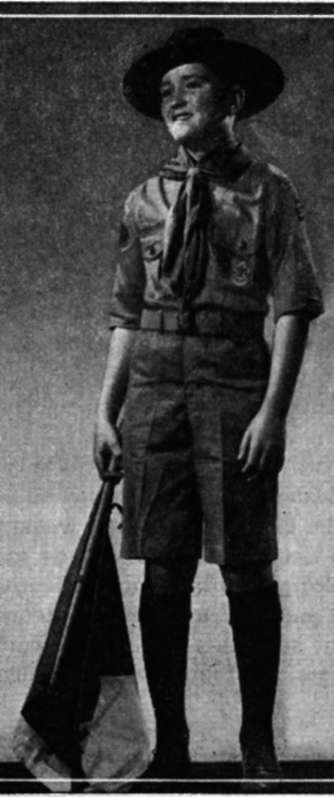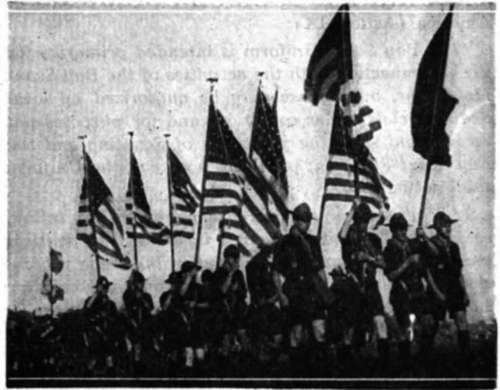Uniform For Scouts
Description
This section is from the book "Handbook For Scoutmasters. Volume 1 & 2", by Boy Scouts of America. Also available from Amazon: Handbook For Scoutmasters.
Uniform For Scouts
Hat-broad-brimmed, olive drab colored.
Shirt-khaki colored, with "Boy Scouts of America" above the right pocket; official buttons.
Shorts (or breeches)-khaki colored.
Belt-khaki colored, web, with metal buckle displaying Scout Badge in clear relief.
Stockings-khaki colored, wool or cotton.
Shoes-tan-colored, bearing official seal.
Neckerchief-of cotton, 30 inches square (or triangular in shape cut diagonally from such a square), in plain or combination colors, as selected by the Troop, District or Council.
Neckerchief Slide-plain or combination color cord, in the form of a Turk's head knot; or made of leather, bone, wood or other handicraft material.
Badges and Insignia-telling to what Patrol and Troop one belongs, and indicating his rank, office and service in Scouting.
Uniform For Scouters
Hat-broad-brimmed, olive drab colored; with leather hat band and leather wind strap. Shirt-as for Scouts. Plain white shirt optional with
Uniform Coat and myrtle-green Necktie. Shorts or Breeches-as for Scouts (Trousers optional, alternative to Shorts or Breeches). Belt-as for Scouts.
Stockings-as for Scouts (dark tan leather puttees optional instead of Stockings with Breeches).
Shoes-as for Scouts (high, dark tan leather if Puttees are worn)

A brand new Uniform-comfortable from the first to the last wearing. Useful, serviceable and handsome.
Neckerchief-as for Scouts. (Myrtle-green Necktie may be worn). Scouter's Coat-khaki colored. Optional. Badges and Insignia-showing rank, office, service,
Troop and community affiliation.
Only One Official Uniform
Remember: There is only ONE Official Boy Scout Uniform and the insignia of our Movement is on every piece of it. Look for it and accept no piece that does not bear the Official Seal. The Uniform is made by the Official National Outfitter, and is sold only by the National Supply Service and by officially appointed Scout Outfitters, and ONLY TO SCOUTS AND SCOOTERS WHOSE UNEXPIRED CERTIFICATES OF MEMBERSHIP IN THE BOY SCOUTS OF AMERICA ARE SHOWN AT TIME OF PURCHASE. No other person is permitted to purchase or wear the Scout Uniform.
The Boy Scouts of America insists upon a high standard of quality in its Official Uniform. It has been proved by experiments through the years that it would be unwise to substitute cheaper materials and poorer workmanship for the quality goods and workmanship now required. The Scout Uniform is made available as a service in making Scouting more effective; and it is manufactured and sold to meet the rigorous requirements of Scout activities and to give complete satisfaction to Scouts and their parents in terms of values received.
Wearing The Scout Uniform
While the National Council has not imposed the wearing of the Official Uniform as a necessary condition of Scouting, it has fixed certain definite requirements upon the Scout who would wear the Uniform.
The Constitution of the Boy Scouts of America states (Article XIV):
"The Badges and other Official Insignia and the Uniform of the Boy Scouts of America shall be made available, and used only by Scouts or officials who have satisfactorily complied with the requirements prescribed by the National Council."

What a thrill as the American Jamboree Contingent marched byl Outstanding Scouts who had proved the value of the Uniform.
Who May Wear The Uniform
Under this rule, the following may wear the Uniform:
1. Any Boy Scout who is regularly enrolled with the National Council, provided he is in good standing in the Troop of which he is a member.
2. All Associate Scouts, Lone Scouts, Veteran Scouts and Scouters who are registered and are in good standing with the local Scout authorities in their respective communities.
According to the By-Laws of the Boy Scouts of America (Article IX):
"The Boy Scout Uniform is intended primarily for use in connection with the activities of the Boy Scout Movement, but its use may be authorized by local Scout officials under conditions and for purposes not inconsistent with the principles of Scouting and the Boy Scout Program; provided, however, the Uniform shall not be used:
1. When soliciting funds or engaging in any selling campaign; 2. When engaging in distinctive political endeavor; 3. When appearing upon the stage professionally without specific authority from the Executive Board". (Section 4.)
"Neither Scouts nor Scout Officials shall wear the Scout Uniform or any Official Scout Badges and Insignia outside the limits of the United States without special credentials from the National Council issued through the Executive Board, authorizing them to do so." (Section 5.)
Suggestions for the wearing of the Uniform follow:
When To Wear The Uniform. Scouts
1. In all formal Scouting activities, such as Patrol and Troop meetings, hikes, camps, rallies, demonstrations. At special church services for Scouts.
2. When appearing for advancement in Scout Rank before formal Courts of Honor or in the presentation of awards.
3. During Boy Scout Week in February.
4. When prescribed for special Scouting service or civic service activities.
5. On such other occasions as may be specifically recommended or prescribed by either the Local or National Council.
Scouters
1. Troop, Tribe, Ship and Patrol Meetings.
2. Hikes, camps, educational trips, cruises, with Patrol, Troop or Council.
3. Rallies, demonstrations, ceremonies, formal Council affairs and similar public events.
4. Special church services for Scouts.
5. Whenever appearing before the public with Scouts.
WEAR THE CORRECT UNIFORM CORRECTLY!
When Not To Wear The Uniform
1. When soliciting funds or engaged in any selling campaign or commercial operation.
2. When engaged in any distinctive political endeavor.
3. When appearing upon the stage professionally without special authority from the Executive Board of the National Council.
4. When taking part in parades except for the purpose of rendering services as a Scout or Scouter, or when officially representing the Boy Scouts of America.
5. When one has ceased to be a Scout or Scouter through failure to reregister or has left the Scout Movement for any other reason.
Uniforming The Troop
"I recognize fully the values of the Uniform to my boys and my Troop," says the Scoutmaster, "and there is nothing in the world that I would rather see than every one of them smartly uniformed. But HOW?"
There is one important key to the solution of that problem: The Scoutmaster's own attitude and his example resulting from that attitude.
You have only to make up your mind to this: "I am getting my own Uniform right away-and shall be wearing it for ALL Troop undertakings!"
With that one point taken care of, you are two-thirds of the way to your goal, because your boys will realize that you mean business, that uniforming is not a vague notion on your part but an accomplishment in which you are vitally interested.
Your Example
When they see you in Uniform at all Troop activiti-ties the boys will feel that they ought to be in Uniform too, and will strive toward that goal. They will reason it out in their own minds: "Our Scoutmaster wears a Uniform. That must mean that all Scouts are supposed to wear one!"
If you do not wear a Uniform they will reason: "Our Scoutmaster doesn't bother about a Uniform, so apparently the Uniform isn't of any special consequence to a Scout."
Continue to:


